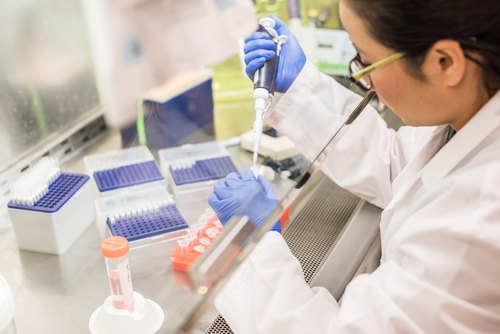Stem Cells in Mouse Hair Seen to Aid Growth of ‘Dense’ Myelin Sheaths Around Nerve Cells, Study Reports

A subset of stem cells in hair follicles, called melanocytes, appear to do more than just give rise to mature melanocytes, cells that help to determine hair color. Those melanocyte stem cells, or McSCs, that carry the CD34 protein were found in hair follicles from mice to differentiate into glia cells and support myelin production, a study reports.
Whether these McSCs also exist in human hair, and so might potentially treat demyelinating diseases like multiple sclerosis (MS) or traumatic nerve injury, will be the focus of further research.
The study, “CD34 defines melanocyte stem cell subpopulations with distinct regenerative properties,” was published in the journal PLOS Genetics.
Hair follicles are skin add-ons made up of different types of cells, including epithelial cells, follicular cells, and pigment-producing melanocytes. Along with these mature cells, different stem cells populations can be found close to hair follicle structures, including McSCs.
Researchers from the University of Maryland School of Medicine explored the abilities of these McSCs.
Using genetically engineered mice, they found two subtypes of McSCs characterized by the presence or absence of the surface protein CD34. In particular, these cells were localized in different cell structures of hair follicles, with CD34- (negative) McSCs being closer to the structures of the root of the hair.
After isolating these two stem cell populations, researchers saw that they showed different cellular patterns with varying levels of several genes.
CD34- McSCs had higher levels of genes linked to mature melanocytes, compared to CD34+ (positive) stem cells. This suggests that CD34- McSCs “are at a more advanced state of melanocytic differentiation,” the researchers wrote.
In comparison, CD34+ McSCs expressed higher levels of neural crest stem cell markers. Further experiments confirmed that CD34+ McSCs had higher levels of genes associated with mature glia cells — cells responsible for providing support to nerve cells — and mature nerve cells.
When researchers cultured both sets of stem cells in the lab, they found that they could transform them into different populations of mature cells. CD34- cells gave rise to about 25% pigmented cells at seven days, while CD34+ cells produced only 5% of pigmented cells.
Indeed, the majority of the CD34+ stem cells retained a non-pigmented appearance. CD34- cells also showed an ability to proliferate more than their CD34+ counterparts, confirming that the two cell populations could be functionally distinct.
Further experiments were done to understand if CD34+ McSCs could mimic the neuroprotective features of neural crest stem cells. Results showed this specific McSC subpopulation could promote the production of new myelin sheaths in nerve cells collected from rats; CD34- cells could not.
A similar myelinating effect was observed in mice neurons after CD34+ McSCs were injected directly into the brain. Researchers, however, could not confirm if this approach might prolong a mouse’s lifespan.
“We describe for the first time that McSCs can be separated into two distinct populations … [and] show that CD34+ McSCs from the HF [hair follicle] bulge unexpectedly possess the ability to function as glia, forming dense myelin sheaths surrounding neurons of the myelin-deficient Shiverer mouse strain,” the researchers wrote. “This finding raises the question of whether all cells previously identified as McSCs uniformly possess melanocytic potential, or whether the CD34+ subset … represents instead another type of neural crest-derived progenitor cell.
“Our findings reveal a novel developmental fate for one subset of McSCs, and suggest approaches to utilize specific, skin-derived stem cell (SDSC) populations for nerve regeneration and support,” their study concluded.
“In the future, we plan to continue our research in this area by determining whether these cells can enhance functional recovery from neuronal injury,” Thomas Hornyak, MD, PhD, senior author of the study, said in a news release.
The team also plans to use the genetic information gathered “to identify similar cells in human skin,” Hornyak added.






